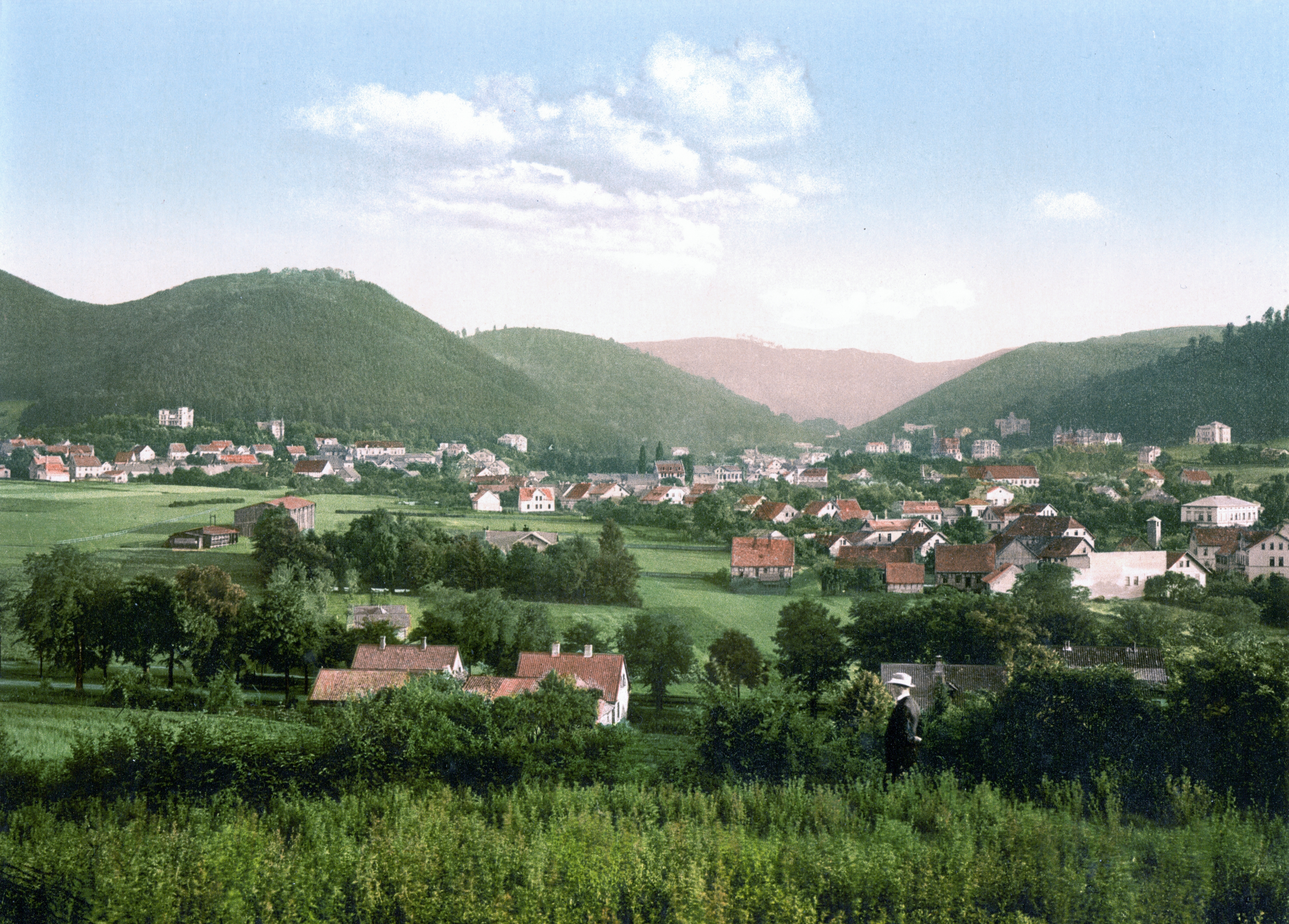|
Oder Valley Railway
The Oder Valley Railway (german: Odertalbahn) was a railway line from Scharzfeld via Bad Lauterberg to St. Andreasberg- Silberhütte. It follows the upper course of the river Oder in the West Harz mountains, and was commonly named after it. Geography The line originated at Scharzfeld station, which has not been served by passenger trains since 2005. This station is situated on the standard gauge South Harz Railway, the main line from Northeim to Nordhausen. From Scharzfeld the line made its way to Bad Lauterberg station, then to the more central halt of Bad Lauterberg-Kurpark, followed by Odertal, Sperrluttertal and St. Andreasberg (Silberhütte/West), from where the St. Andreasberg rack railway continued to St. Andreasberg Stadt. Between Bad Lauterberg and Bad Lauterberg Kurpark, a narrow-gauge industrial railway built for the transport of baryte crossed the line. History The line was opened in 1884. In order to provide a better link from the terminus at St. Andreasberg West t ... [...More Info...] [...Related Items...] OR: [Wikipedia] [Google] [Baidu] |
South Harz Railway
The South Harz Railway (german: Südharzstrecke or ''Südharzbahn'') is a railway line through the German states of Lower Saxony and Thuringia. It runs from Northeim to Nordhausen, via Herzberg am Harz, Bad Lauterberg-Barbis, Bad Sachsa, Walkenried and Ellrich. The line is long. Route The South Harz line runs roughly east–west, with Northeim lying further north than Nordhausen. It runs from the Leine valley along the Rhume and the Oder (Harz) rivers with normal grades through Katlenburg-Lindau to Herzberg am Harz. From there it rises on a grade of up to 1.06% through Scharzfeld and Barbis to the former station of Osterhagen, the highest point of the line. The line falls gently and runs south of Bad Sachsa to Walkenried. To the east is the only tunnel on the line, connecting to the valley of the Zorge. Shortly after the tunnel is the border of Lower Saxony and Thuringia, the former Inner German border. From Ellrich the line follows the Zorge to Nordhausen. The Harz Railway ('' ... [...More Info...] [...Related Items...] OR: [Wikipedia] [Google] [Baidu] |
Bad Harzburg
Bad Harzburg (; Eastphalian: ''Bad Harzborch'') is a spa town in central Germany, in the Goslar district of Lower Saxony. It lies on the northern edge of the Harz mountains and is a recognised saltwater spa and climatic health resort. Geography Bad Harzburg is situated at the northern foot of the Harz mountain range on the edge of the Harz National Park. To the east of the borough is the boundary between the states of Lower Saxony and Saxony-Anhalt, the former Inner German Border. The small ''Radau'' river, a tributary to the Oker, has its source in the Harz mountains and flows through the town. Nearby are the towns of Goslar to the west, Vienenburg to the north, Braunlage to the south and Ilsenburg and Osterwieck in the east. Bad Harzburg is rich in natural resources such as gabbro, chalk, gravel, and oolithic iron ore (former Hansa Pit), all of which are or were mined in today's city's area. Climatically Bad Harzburg is a transition zone to a pure alpine region with a pro ... [...More Info...] [...Related Items...] OR: [Wikipedia] [Google] [Baidu] |
Goslar (district)
Goslar () is a district in Lower Saxony, Germany. It is bounded by (from the south and clockwise) the districts of Göttingen, Northeim, Hildesheim and Wolfenbüttel, the city of Salzgitter, and by the states of Saxony-Anhalt (district of Harz) and Thuringia (Nordhausen). History The history of the district is linked with the city of Goslar. The district of Goslar was established in the 19th century by the Prussian government. The city of Goslar did not belong to the district until 1972, when it was eventually incorporated into the district. Langelsheim merged 1 November 2021 with the three municipalities of the Samtgemeinde Lutter am Barenberge, which was abolished. Geography The region comprises the northwestern part of the Harz mountains. The Harz National Park is part of this district. The highest peak is the Wurmberg (971 m) near Braunlage, also being the highest elevation of Lower Saxony. Above the small town of Altenau there is the source of the Oker river, which runs thro ... [...More Info...] [...Related Items...] OR: [Wikipedia] [Google] [Baidu] |
Transport In The Harz
Transport (in British English), or transportation (in American English), is the intentional movement of humans, animals, and goods from one location to another. Modes of transport include air, land (rail and road), water, cable, pipeline, and space. The field can be divided into infrastructure, vehicles, and operations. Transport enables human trade, which is essential for the development of civilizations. Transport infrastructure consists of both fixed installations, including roads, railways, airways, waterways, canals, and pipelines, and terminals such as airports, railway stations, bus stations, warehouses, trucking terminals, refueling depots (including fueling docks and fuel stations), and seaports. Terminals may be used both for interchange of passengers and cargo and for maintenance. Means of transport are any of the different kinds of transport facilities used to carry people or cargo. They may include vehicles, riding animals, and pack animals. Vehicles may inclu ... [...More Info...] [...Related Items...] OR: [Wikipedia] [Google] [Baidu] |
Railway Lines In Lower Saxony
Rail transport (also known as train transport) is a means of transport that transfers passengers and goods on wheeled vehicles running on rails, which are incorporated in tracks. In contrast to road transport, where the vehicles run on a prepared flat surface, rail vehicles (rolling stock) are directionally guided by the tracks on which they run. Tracks usually consist of steel rails, installed on sleepers (ties) set in ballast, on which the rolling stock, usually fitted with metal wheels, moves. Other variations are also possible, such as "slab track", in which the rails are fastened to a concrete foundation resting on a prepared subsurface. Rolling stock in a rail transport system generally encounters lower frictional resistance than rubber-tyred road vehicles, so passenger and freight cars (carriages and wagons) can be coupled into longer trains. The operation is carried out by a railway company, providing transport between train stations or freight customer faciliti ... [...More Info...] [...Related Items...] OR: [Wikipedia] [Google] [Baidu] |
Bundesstraße 243
The B 243 runs from Hildesheim over Seesen and Herzberg am Harz to Nordhausen. Route Districts and municipalities * Lower Saxony ** Hildesheim (district) *** Hildesheim *** Diekholzen: Egenstedt *** Bad Salzdetfurth: Groß Düngen, Wesseln *** Bockenem: Nette, Bönnien, Bockenem, Bornum ** Goslar (district) *** Seesen: Rhüden, Bornhausen, Seesen, Engelade, Münchehof ** Osterode am Harz (district) *** Samtgemeinde Bad Grund: Gittelde, Windhausen, Badenhausen *** Osterode am Harz: Katzenstein, Lasfelde, Petershütte, Osterode, Osterode-Leege *** Hörden am Harz: Aschenhütte *** Herzberg am Harz: Herzberg, Scharzfeld *** Bad Lauterberg im Harz: Barbis, Bartolfelde, Osterhagen *** Bad Sachsa: Nüxei * Thuringia ** Nordhausen (district) *** Hohenstein: Mackenrode, Holbach *** Werther: Günzerode Combined routing * From Seesen to AS Engelade combined with the B 248 * Between AS Münchehof and Bad Grund combined with the B 242 * In Osterode between O ... [...More Info...] [...Related Items...] OR: [Wikipedia] [Google] [Baidu] |
DB Class 614
The DB Class 614s are German diesel multiple units operated by the Deutsche Bundesbahn, comprising two Class 614 driving units and up to two Class 914 centre cars. On 1 January 1994 the ownership of these vehicles was transferred to the DB's legal successor ''Deutsche Bahn'' and its subsidiaries or business areas. The Class 614 is a direct evolution of the Class 624 / 634 and only differs from them in a few points of detail. As a result, the technical section will only cover these differences. History Prototypes In 1971 the prototypes, 614 001 + 914 001 + 614 002 and 614 003 + 914 002 + 614 004, were delivered. Testing was carried out from Trier along the Moselle valley and into the Eifel. Unlike the production vehicles the prototypes had a tilting systems. Production units Full production by MAN SE and the ''Uerdingen Waggonfabrik'' began in 1973. The first series of 25 three-coach units was delivered at the time when so-called "pop liveries" were in vogue and so they w ... [...More Info...] [...Related Items...] OR: [Wikipedia] [Google] [Baidu] |
DB Class VT 24
Class 624 and class 634 are types of diesel multiple unit, originally operated by Deutsche Bahn. Development Whereas during the first years after World War II the focus of the Deutsche Bundesbahn was on repairs of rolling stock, lines and buildings, with the beginning of the 1950s attention shifted to renewal of the trains. For passenger services on not electrified lines, the first prototypes of main line diesel locomotives such as the class 220 were commissioned in 1953. Subsequently, DB ordered the rail industry to develop new DMUs in order to replace pre-war classes and steam traction. In 1961 MAN and Waggonfabrik Uerdingen both delivered two prototypes each. Even though they were quite similar, they can be distinguished easily by the different front design. DB put the prototypes into service as class VT 23.5 (MAN) and class VT 24.5 (Uerdingen). After the new numbering scheme the prototypes were listed as class 624 together with the regular units. The prototypes underwen ... [...More Info...] [...Related Items...] OR: [Wikipedia] [Google] [Baidu] |
DB Class 628
The DB Class 628 is a twin-car, diesel multiple unit operated by the Deutsche Bahn for local passenger rail services. Design ''(The following description is primarily related to the Class 628.4, and is largely valid for the other variants as well)'' Each coach rests on two twin-axle bogies. Only the bogie at the close-coupled end of the coach is driven. Power transmission from the motor is achieved using a ''Voith'' hydrodynamic transmission system with a converter (''Wandler'') and a T 311r coupling. Up to Class 628, a T 320 double-converter transmission was used. Motor and transmission are suspended elastically under the lightweight coach body. The operating brake is an automatic compressed air KE disc brake with automatic load braking and electronic anti-skid protection. In addition, for rapid braking, electromagnetic rail brakes are used; these can also be activated separately if required. Coupled running enables up to four coupled pairs of coaches to be driven from one dri ... [...More Info...] [...Related Items...] OR: [Wikipedia] [Google] [Baidu] |
Diesel Multiple Unit
A diesel multiple unit or DMU is a multiple-unit train powered by on-board diesel engines. A DMU requires no separate locomotive, as the engines are incorporated into one or more of the carriages. Diesel-powered single-unit railcars are also generally classed as DMUs. Diesel-powered units may be further classified by their transmission type: diesel–mechanical DMMU, diesel–hydraulic DHMU, or diesel–electric DEMU. Design The diesel engine may be located above the frame in an engine bay or under the floor. Driving controls can be at both ends, on one end, or in a separate car. Types by transmission DMUs are usually classified by the method of transmitting motive power to their wheels. Diesel–mechanical In a diesel–mechanical multiple unit (DMMU), the rotating energy of the engine is transmitted via a gearbox and driveshaft directly to the wheels of the train, like a car. The transmissions can be shifted manually by the driver, as in the great majority of first-gen ... [...More Info...] [...Related Items...] OR: [Wikipedia] [Google] [Baidu] |




.jpg)
